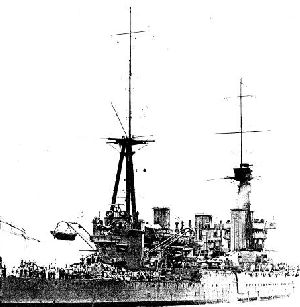- Author
- Stevens, David
- Subjects
- Ship histories and stories
- Tags
-
- RAN Ships
- HMAS Australia I
- Publication
- September 2008 edition of the Naval Historical Review (all rights reserved)
‘There would be an element of tragedy in such an end to any ship; but when the ship represents as much, and suggests as much, as the Australia does, the tragedy becomes great indeed, for into it is imported a national, almost personal sense of loss as of a well-loved and heroic soul. The Australia was well named – she did, in very truth, and in a higher way even than those who named her could have deemed possible, represent this Australian people; and by the dignity and worth and power of her representation, she helped us largely to our nationhood.’ Editorial, Sydney Morning Herald, 12 April, 1924

On Saturday, 12 April 1924, the Royal Australian Navy made final preparations to scuttle its first flagship. Accompanied by the light cruisers HMA Ships Melbourne, Brisbane and Adelaide, and the destroyers Anzac and Stalwart, the battle cruiser Australia lay helpless and wallowing 24 miles east of Sydney Heads. She still flew the Commonwealth flag at her bow and the white ensign at her stern, but Australia was no longer a national or naval asset. Everything of value had been removed and everything warlike had been mutilated. Just eleven years old, the former ‘pride of the Southern Seas’ was now an unseaworthy 18,000-ton hulk, streaked with rust and grime and already listing several degrees to port. Constructed with some 500 separate compartments, the whole ship had since been completely gutted. Daylight now penetrated from the upper deck through to the bilges, where it dimly revealed a sloshing accumulation of rainwater and a hopeless tangle of debris.
Although the object of their attention was but an empty shell, those in the surrounding ships stood to silent attention and watched intently as the scuttling party completed its work. Just after 1430, there came the final message from Australia: ‘Everything is open’, followed by an exodus to the waiting Brisbane. Even as the last man clambered over her side, a smothered explosion shook Australia and blew a gaping hole in the bottom of her hull. The list increased only slowly, but with each succeeding swell, she heeled over a little more. ‘She was going to her death gracefully,’ remarked one observer, ‘in a manner becoming a great ship.’ Finally, after some twenty minutes, the huge holes cut in her upper sides touched the waterline and the sea rushed in unhindered. In less than a minute, Australia had rolled over and plunged out of sight, stern first. An RAAF aircraft dropped a single small wreath onto the calm waters, and at five second intervals Brisbane fired a Royal Salute of twenty one guns. Then all was silent. The remaining navy vessels formed into a single line and turned west towards home.
Far more than being a simple and dignified naval ceremony, this had been an opportunity for the whole nation to ensure that Australia did not depart without honour. Prime Minister Stanley Bruce and other senior dignitaries were embarked in Melbourne, the Naval Board flew its flag in Anzac, and in Brisbane an army of pressmen, photographers and painters recorded the scene. Several large steamers crowded with thousands of sightseers were also there to pay their last respects, while floral tributes from clubs, societies and individual citizens meant that great masses of wreaths had hung from Australia’s mangled bridge. There had been no funeral music and no speeches, but the Sydney Morning Herald found the tense silence and subdued emotion quite stirring. Comparing the scuttling to the passing of a great man, the newspaper declared it ‘One of the most deeply impressive scenes in Australian history’, which left on those watching, ‘the impress of sadness beyond articulation’.
No other Australian fighting ship has ever received such solemnity and moving ritual at its end, and one must ask what it was that made this vessel unique? After all, the relatively lightly armoured battle cruiser was considered by many to be a flawed design, and Australia earned no official battle honours for her part in the Great War. She missed the Battle of Jutland following a collision, and instead of firing her 12-inch guns in anger, had spent almost four years employed on the essential, but monotonous and largely thankless task of North Sea patrol. It was an undertaking said to have driven at least one sailor insane, and was hardly a model for a nation which since 1915 had prided itself on the Anzac fighting tradition. Indeed to understand the mixture of affection and gratitude shown by the Australian people at the battler cruiser’s end, we must look before the war when she was conceived, built and then brought into service as Australia’s ‘first burst into Nationhood’.




